Eggplant hair color: who suits and how to get it?

The fair sex often experiment with hair color. Some people choose very unusual shades. These include ripe eggplant. Once this tone was considered quite fashionable, but today some of its variations can be entered into a stylish image. Let's figure out who suits the eggplant color, and how to get it.



Shades
Eggplant color is multifaceted. It includes a variety of sophisticated halftones. It can be light or dark, muted or bright. In any case, the color looks impressive on the hair. It gives the hairstyle a visual volume, and the look - expressiveness, makes the image mysterious.
There are three main shades of eggplant:
- color with a bright purple tint;
- deep plum shade;
- reddish tone.
Each of the options is beautiful in itself. However, when choosing, one should take into account the type of appearance, age, and also some other points.
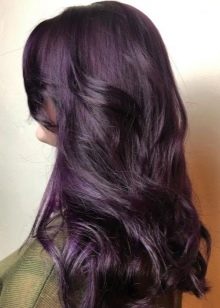


Who is it suitable for?
Eggplant color suits young and middle-aged people with flawless skin. Any redness, acne, rosacea, scars and other defects will only emphasize such a shade.
Saturated, bright colors are suitable for young girls. Purple strands look especially relevant.
Middle-aged women need to be careful with this color, as it can visually add a couple of years and make the whole look cheaper.
To prevent this from happening, it is better to opt for deep, dark colors (close to brown or black) or “dusty” cold shades.



As for the undertone, purple looks better on girls with pale skin, gray, blue, gray-green eyes. Plum and reddish tones are more harmoniously combined with hazel, amber, nut green eyes and a warm skin tone. Swarthy girls are better off choosing darker color variations. White-skinned young ladies with light eyes can also be painted in light shades.



If we talk about the hairstyle, eggplant shades look most impressive on loose hair laid in waves. The color also looks beautiful on girls with squares, stepped hairstyles. Creative short haircuts also emphasize the unusual tone advantageously.



Coloring options
Modern fashion includes 2 directions: natural shades and bright colors. And also complex coloring, beautiful color combinations are in trend. Therefore, in addition to changing the color of the entire hair length, today there are many options for transformation.
Ombre will look beautiful on natural dark and light brown hair. A smooth transition from a natural shade to a bright one should be harmonious. Dark brown hair pairs better with reddish and plum eggplant tones. Blacks can blend into any saturated color. If light brown curls have a cold tone, the combination with "dusty" purple will turn out to be effective.
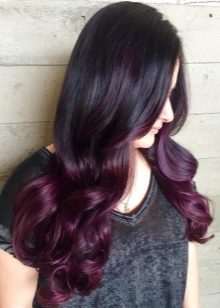
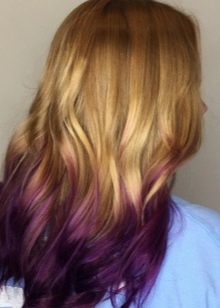

You can paint individual strands in a bright juicy color. This option is more suitable for young girls. For adult ladies, you can use coloring that forms a mesmerizing play of dark eggplant color and chocolate tones.



The transition from dark to light eggplant looks just as interesting. The combination of color with blue or pink turns out to be beautiful. Of course, such experiments are also suitable only for young beauties.


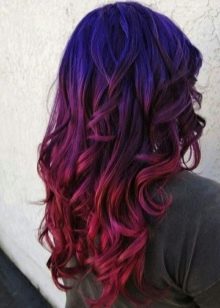
Advantages and disadvantages
Can be distinguished a few pluses of the eggplant palette:
- due to the depth of color, the hair looks thicker;
- all shades look impressive, eye-catching;
- a variety of coloring options allows you to create both a shocking and an intelligent "expensive" image;
- the desired color can be obtained not only by applying permanent paint, but also using tinting agents.



Unfortunately, there are also disadvantages:
- the color is not suitable for everyone (ladies of a respectable age and girls with skin problems are better off choosing more natural tones);
- bright shades are quickly washed out.


Choice of paint
You can get a beautiful eggplant tone in three ways: with the help of hair dye, tinting agent (foam, mousse, balm, mask) and colored henna. Let's consider each option in more detail.
Toning agents
This option is ideal for those who are not sure about the choice of shade, or just want to change the image for a while. Such products do not contain ammonia, do not lighten the hair, but are simply superimposed on top of a natural color with a light veil. A slight tint appears on dark hair. On light strands, the tone may turn out brighter. And also the intensity of the color depends on the time of exposure of the product to the hair structure.



If you limit yourself to one application, the shade is washed out pretty quickly. After a couple of weeks, you can try a different tone, switch to persistent dye, or just stay the same.
However, it should be noted that eggplant may not be completely washed off from pre-bleached hair.
As for unlightened strands, there are usually no marks on dark hair, but fair-haired and natural blondes should be careful.
Judging by the reviews, it can be difficult, and sometimes even impossible, to completely get rid of bright toning in such cases.
Popular shading products on the market:
- balm "Tonic";
- balm Syoss;
- Estel Solo Ton shampoo;
- shampoo Irida M;
- shampoo Kapous Life Color and others.
All of these products have an eggplant color in the palette.

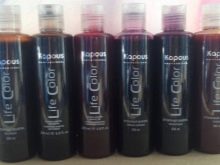

Permanent paints
Such compositions give a rather persistent shade. Even when the brightness of the color fades, a pinkish or reddish tone remains. It will be difficult to return to your native color after such a change. If you change your mind and want to become the owner of a natural hairstyle again, you will have to resort to re-coloring, and possibly a preliminary chemical wash. Therefore, deciding on such a step, you need to think it over well.
As for specific firms, almost all manufacturers that produce paints for home and professional use include this shade in the palette. The most popular are:
- Estel;
- Wella;
- Palette;
- L'Oreal Preference;
- Syoss;
- Garnier Color Sensation and many others.

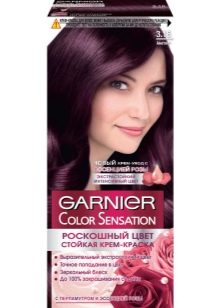

Colored henna
Tint henna is a product obtained by mixing natural powder with artificial dye. According to its characteristics, it can be equated with tint balms and shampoos, although the shade in this case lasts longer. However, this henna has several disadvantages. In some cases, the product may cause an allergic reaction.
In addition, it dries hair, so some girls add oils to the coloring mixture.
To consider the product absolutely harmless and natural, of course, is not worth it. There are much more chemicals in it than natural ones.

Subtleties of coloring
Of course, it is better to visit the salon, entrusting the matter to a professional. This is especially true for complex staining techniques. But if you settled on a monochrome version and want to save money, you can carry out the procedure at home.
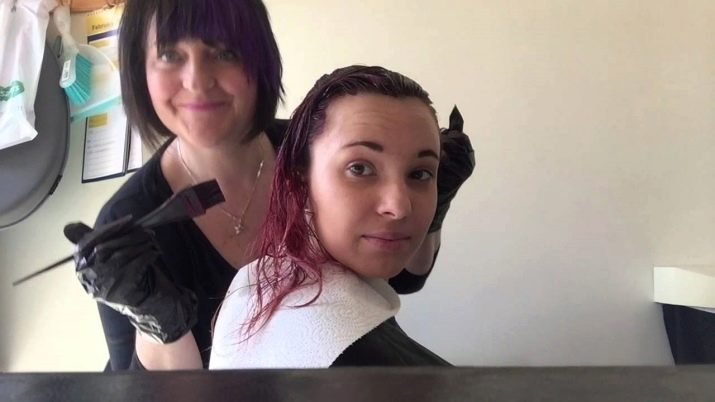
Read the instructions on the packaging carefully. And also remember that regardless of the type of coloring agent, the intensity of the shade will be related to the original hair tone. On dark curls, you will get a calmer and deeper color, on light and discolored ones - brighter.
Before the procedure, it is advisable to conduct a test to make sure that there is no allergy to the components of the product.
And also it should be borne in mind that you cannot use tint products earlier than 3 weeks after chemical exposure to the strands (lightening, perm, keratin straightening). Otherwise, the result may be unpredictable.


If you decide to use Tonic balm, it should be applied to clean, damp hair.spreading evenly with a plastic comb or brush. Do not forget to wear gloves and protect the skin on your forehead with a greasy cream from accidental staining. After 5-20 minutes, the product is washed off with warm water. The exposure time depends on the intensity of the desired color. Rinse your hair until the water becomes clear.

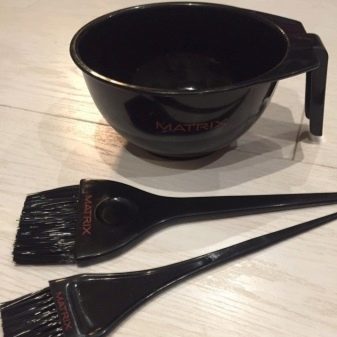
If drops of the product get on the plumbing or the floor, they should be removed immediately. Otherwise, the dye will be difficult to wash off. It is not necessary to use a regular balm after coloring, the product already contains conditioning additives. It is not recommended to use metal hairpins during the procedure.
Shampooing your hair in a similar way. The shampoo is applied to wet, clean hair and kept for 3 to 20 minutes (depending on the company). Then the product is thoroughly washed off with water. The result is fixed with a balm for colored hair.

The permanent staining procedure is also quite simple. The dye is mixed with an oxidizing agent and applied to the hair. The only caveat is that the uniformity of application is especially important here. Therefore, the hair is divided into small strands, and a special brush is used. After the time specified in the instructions expires, the composition is washed off, the procedure is completed with a special balm (usually it is included in the kit).


Hair care
The brightness and saturation of the eggplant hue must be maintained, otherwise the color will quickly become faded and expressionless. To cleanse your hair and scalp, it is recommended to use only special shampoos and conditioners designed for colored strands. They are aimed at gentle action and protection against washout.
Between staining with paint, you can maintain the color with a tint shampoo. If you initially used this option, and you like it, you just need to repeat the procedure regularly. The effect will be cumulative.


Avoid using oil masks as they will wash out the color. But you can and even need to use protective equipment when styling your hairstyle with a hairdryer, iron, curling iron and when going outside. Bright shades look much better on shiny, well-groomed hair.


See below for more details.








